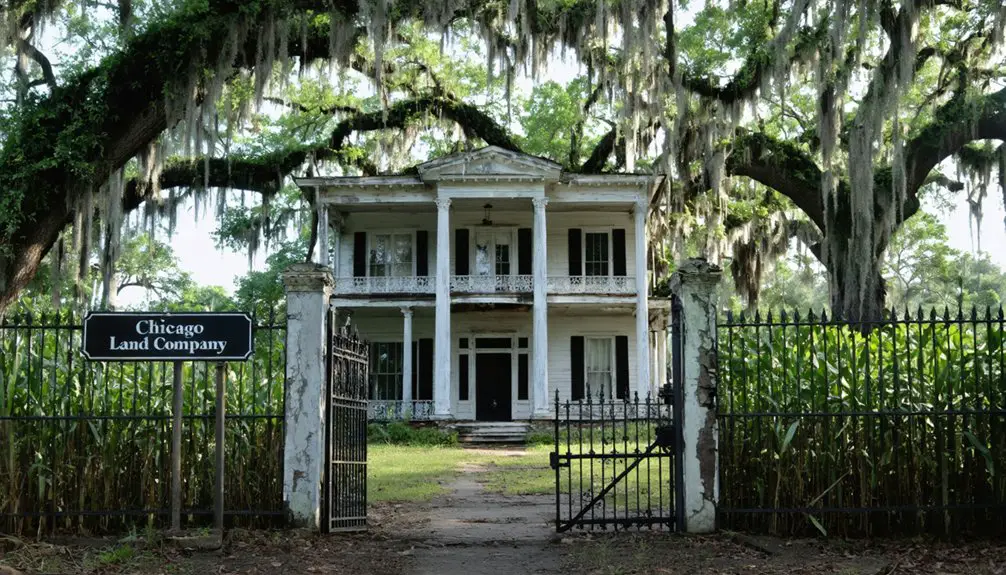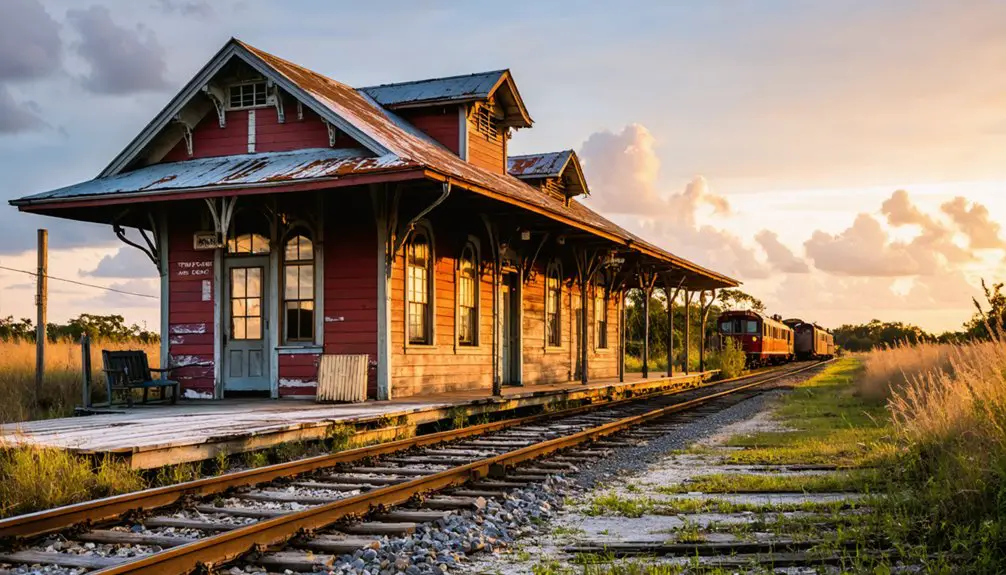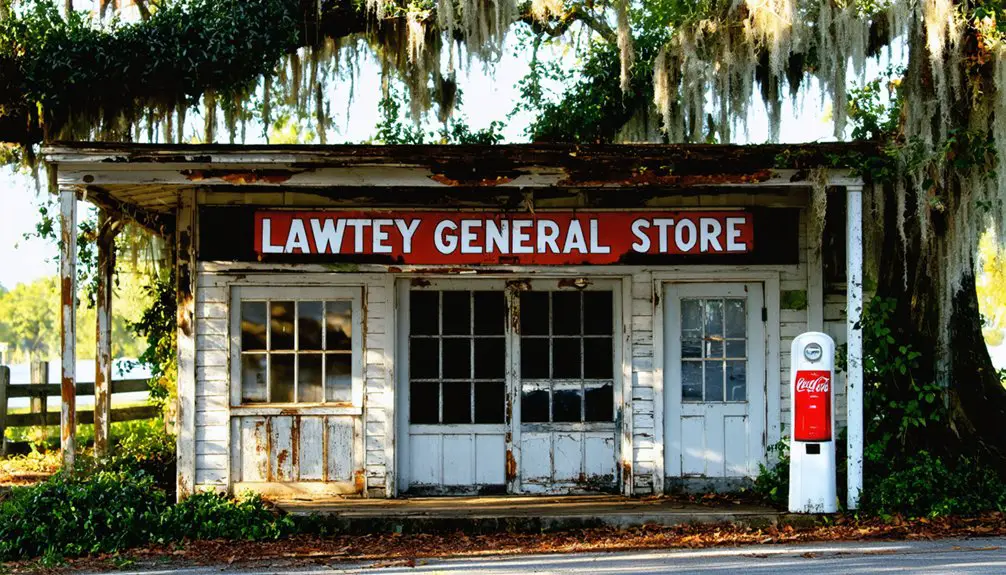You’ll find Lawtey, Florida at an intriguing crossroads between life and abandonment. This small town, founded by Chicago investors in 1877, flourished with sawmills and cotton gins before descending into gang violence in the early 1900s. Today, residents live alongside abandoned historic structures, including a preserved wooden train depot that reflects northern settler influence. The town’s unique status as a partially inhabited ghost town holds deeper stories of economic boom, cultural shifts, and preservation efforts.
Key Takeaways
- Lawtey maintains an inhabited status while displaying ghost town characteristics through numerous abandoned buildings and deteriorating infrastructure.
- The town experienced severe economic decline following early 1900s gang violence, leading to plummeting property values and reduced commercial activity.
- Historic wooden structures from Chicago settlers remain preserved, serving as municipal buildings and testifying to the town’s railroad-driven past.
- Low property values and minimal investment have created a dual landscape of active residences alongside abandoned storefronts and homesteads.
- Despite ongoing habitation, Lawtey struggles with maintaining essential services and modernization, reinforcing its partial ghost town status.
The Chicago Vision: Northern Investors Create a Southern Settlement

During the post-Civil War era, Chicago investors spearheaded an ambitious initiative to establish new settlements in Florida’s untapped territories. Their investment motivations centered on capitalizing on the South’s affordable land prices and abundant natural resources, particularly in agriculture and timber.
You’ll find these Northern capitalists organized through syndicates to pool their resources, implementing strategic settlement strategies that went far beyond simple land acquisition. Similar to modern securities fraud cases, these historical investment ventures required careful oversight to protect investor interests. Settlement arrangements often reached $25 million in today’s equivalent purchasing power.
Their vision included extensive development plans featuring railroad connections, processing facilities, and essential infrastructure. You’re looking at a carefully orchestrated effort to create sustainable communities that could attract settlers and businesses alike.
The investors understood that success required more than just capital – it demanded a complete economic ecosystem with mills, gins, and transportation networks to support long-term growth.
From Sawmills to Cotton Gins: Early Economic Growth
As Lawtey shifted from raw frontier to established settlement, sawmills and cotton gins emerged as the twin engines of its early economic growth.
You’ll find that sawmill operations provided essential lumber for construction while creating local jobs and export opportunities. The timber industry’s success intertwined perfectly with the expanding railroad network, making transport of materials more efficient.
Cotton production soon dominated the agricultural landscape, with cotton gins revolutionizing how local farmers processed their crops. These gins increased efficiency and allowed farmers to expand their acreage considerably. The Timucua and Seminole tribes had previously utilized this fertile land for their own agricultural practices. Many settlers from Virginia and Carolina migrated to the area, drawn by the agricultural opportunities.
You can trace Lawtey’s economic integration through its strategic rail connections, which helped transport cotton, lumber, and other agricultural goods to wider markets. The Atlantic & Gulf railroad proved particularly crucial in connecting Lawtey’s products to buyers throughout Florida and neighboring states.
Violence and Lawlessness: A Town’s Downward Spiral
You’ll find that Lawtey’s descent into violence began in the early 1900s when rival gangs carved out territories and engaged in deadly power struggles throughout the town.
The murder rate soared as gang conflicts erupted in public spaces, creating an atmosphere of constant fear and instability for residents.
Local law enforcement proved inadequate to contain the violence, leading many citizens to arm themselves and travel in groups after dark for protection.
The turmoil of this era was a stark contrast to the town’s hopeful beginnings when Chicago settlers arrived seeking a better life in 1877.
Like many other communities during this period, the town’s troubles intensified when Spanish control ended and territorial changes brought uncertainty to Florida’s governance.
Rival Gang Territory Wars
The early 1900s marked a dark turning point in Lawtey’s history when rival gangs transformed this small Florida town into a battleground of territorial warfare.
Today Lawtey is known primarily as a notorious speed trap along the highway.
Despite its tiny population of around 700, violence escalation reached disproportionate levels as gang alliances fought for control over local businesses and trade routes.
You’d have witnessed frequent gun battles and public shootings that disrupted daily life, while organized factions wielded significant firepower in their quest for dominance.
The violence wasn’t just about physical territory – it represented a broader struggle for economic control.
Rival groups targeted key assets and transport corridors, turning commercial disputes into deadly confrontations, similar to how white mobs attacked African-American residents in other Florida towns during this era.
As fear gripped the community, property values plummeted and local commerce suffered, creating a cycle of desperation that fueled further territorial conflicts.
Murder Rate Skyrockets 1900s
Rising tensions between rival gangs inevitably sparked a dramatic surge in Lawtey’s murder rate during the early 1900s. You’d have witnessed the town’s murder statistics climb from 4.5 deaths per 100,000 residents in 1910 to alarming levels in subsequent decades.
The crime patterns revealed young males aged 18-24 as both primary victims and perpetrators, accounting for 77% of homicides. Similar to national trends showing property crime dominates total crime statistics, Lawtey saw a surge in burglaries and theft alongside the violence.
The town’s declining economic conditions, coupled with ineffective law enforcement and Prohibition-era bootlegging, created a perfect storm of violence. Mirroring the state’s trends, the town experienced a 457% increase in violent crime rates between 1960 and 1990.
African American residents faced disproportionately higher victimization rates during this period of social instability.
Lawtey’s experience mirrored other small Florida towns, where limited police resources and rural isolation left communities vulnerable to unchecked violence, fundamentally altering the town’s trajectory toward lawlessness.
Law Enforcement Proves Ineffective
Despite initial efforts to maintain order, Lawtey’s law enforcement faced mounting challenges during the town’s economic decline, struggling to control escalating violence beyond simple traffic violations.
You’d find a police force overwhelmed by growing lawlessness while focusing primarily on traffic fines as a revenue source. Their limited resources and manpower couldn’t effectively address serious crimes or maintain adequate patrols throughout the deteriorating town.
As abandoned buildings multiplied and poverty increased, law enforcement challenges intensified.
Community trust eroded when police proved unable to prevent rising violence or respond quickly to incidents. While officers attempted to maintain a small-town approach with proactive patrols, their effectiveness was severely compromised by budget constraints and insufficient staffing, leading to a cycle of declining safety and diminished public confidence.
Architectural Legacy: Train Depot and Historic Structures

Railroad heritage anchors Lawtey’s architectural legacy through its historic train depot, constructed around 1877 by the Seaboard Air Line Railroad. The wooden structure, built during the town’s founding by 30 Chicagoans, features a rectangular plan with a covered platform that once sheltered passengers and goods during Lawtey’s economic heyday.
You’ll find the depot’s architectural significance in its well-preserved utilitarian style, complete with simple trim and a pitched roof – hallmarks of late 19th-century Florida railroad buildings.
Unlike its brick-built contemporary in Lloyd, Lawtey’s depot maintains its relevance through adaptive reuse as a municipal building. Located one block west of U.S. 301, it stands as a representation of the railroad era that transformed this small Florida town into a bustling center of trade and commerce.
Ghost Town Status: Living Among the Remnants
While Lawtey maintains its official status as an inhabited town, you’ll find a striking dichotomy between active residences and abandoned structures that earned it the label of a ghost town.
The community’s resilience shines through as residents forge their daily lives amid deteriorating infrastructure and empty buildings, shaping a unique community identity.
- Low property values and lack of investment perpetuate the cycle of partial abandonment
- Essential services continue but struggle with maintenance and modernization
- Residents navigate between functioning neighborhoods and deserted historic zones
- Limited economic opportunities reinforce the town’s ghost town characteristics
- Environmental challenges persist with overgrown lots and decaying structures
Despite these challenges, you’ll witness a determined population carrying on their lives, adapting to an environment that tells the story of both decline and endurance.
The Cultural Impact on Florida’s Historical Landscape

In Lawtey’s fading structures, you’ll find tangible evidence of northern settler influence through architectural styles that mirrored those of Georgia and the Carolinas.
The town’s remaining buildings serve as essential markers for preserving Florida’s rural heritage, documenting the shift from agricultural prosperity to economic decline.
You can trace the cultural legacy of early settlement patterns through Lawtey’s abandoned storefronts, churches, and homesteads, which stand as silent witnesses to the region’s changing socioeconomic landscape.
Rural Heritage Preservation Efforts
Through coordinated preservation initiatives across Florida’s rural communities, heritage conservation efforts have generated significant economic and cultural impacts on the state’s historical landscape.
You’ll find rural revitalization programs, like the Florida Main Street Program, actively connecting public investments with private partnerships in over 80 communities statewide.
- State preservation grants have leveraged over $212.1 million since 1983, doubling local investment
- Historic preservation activities generate 123,000 jobs in manufacturing and restoration
- The Florida Master Site File protects over 200,000 cultural resources
- Preservation efforts contribute $4.2 billion annually to Florida’s economy
- Integration of cultural and natural resource management strengthens community resilience
These preservation initiatives protect both tangible heritage and the economic significance of rural Florida, ensuring these historical treasures continue enriching future generations.
Northern Settlement Cultural Influence
Native American cultures from the northern regions profoundly shaped Florida’s historical landscape, particularly through the Seminole peoples who migrated from Creek Indian groups in Georgia and Alabama.
These northern influences transformed Lawtey’s early development through established agricultural practices and settlement patterns focused around water sources and fertile soils.
You’ll find evidence of cultural assimilation in the area’s history, where European missionaries worked to convert native populations while indigenous groups maintained their traditional practices.
The Seminoles’ fierce resistance to removal policies demonstrated their determination to preserve their way of life. Their agricultural expertise in growing corn, beans, and squash influenced local farming methods, while their strategic settlement choices near reliable water sources created lasting impacts on how communities like Lawtey developed their infrastructure and farming systems.
Legacy Through Abandoned Architecture
While exploring Lawtey’s abandoned architecture, you’ll encounter tangible remnants of Florida’s evolving cultural landscape, particularly along U.S. Highway 301.
The architectural memory of this once-bustling town tells profound stories through its weathered structures and repurposed buildings, like the Old Train Depot.
These abandoned narratives reveal themselves through:
- Dilapidated souvenir stands and restaurants that mark shifting tourism patterns
- The historic train depot, now serving municipal functions, showcasing adaptive reuse
- Weather-beaten storefronts that chronicle economic upheaval and demographic change
- Ghost town structures that challenge modern notions of progress
- Crumbling commercial buildings that preserve regional identity and cultural heritage
You’re witnessing more than decay – these architectural remnants serve as powerful cultural markers, documenting Florida’s complex historical geography through their silent testimony.
Frequently Asked Questions
What Is the Current Population of Lawtey?
You’ll find Lawtey’s current demographics show approximately 670 residents as of 2023, though historical significance of population growth suggests it’ll reach between 682-705 people by 2025, based on various projections.
Are There Any Active Businesses Still Operating in Lawtey Today?
You’ll find active businesses in Lawtey’s business landscape, including Magnolia Home Center and several local shops, supported by the city’s economic development programs and highway-accessible location on US-301.
Can Visitors Legally Explore the Abandoned Buildings in Lawtey?
While you might want to explore abandoned buildings, you can’t legally enter them without explicit owner permission. Contact local authorities first to avoid trespassing charges and get proper authorization.
What Happened to the Original Chicago Investors’ Descendants?
You won’t find investor legacy records or descendant stories in modern Lawtey, as these Chicago families dispersed over generations. They’ve left no documented financial holdings or significant influence in today’s community.
Does Lawtey Have Any Annual Festivals or Community Events?
You won’t find dedicated annual celebrations in Lawtey itself, but you’ll enjoy nearby community gatherings like Bradford County’s Strawberry Festival, The Arc’s Fall Festival, and regional holiday events.
References
- http://www.papergreat.com/2016/08/photos-dilapidated-souvenir-land-near.html
- https://digitalcommons.unf.edu/historical_architecture_main/6236/
- https://freepages.history.rootsweb.com/~gtusa/usa/fl.htm
- https://cityoflawtey.org/our-history/
- https://en.wikipedia.org/wiki/List_of_ghost_towns_in_Florida
- https://www.eb5investors.com/blog/eb5-fraud-settlement/
- https://www.loftusandeisenberg.com/results/
- https://www.cookcountytreasurer.com/pdfs/siestudy/SIEStudy.pdf
- https://attorneygenerallynnfitch.com/wp-content/uploads/2021/11/Final-Distributor-Settlement-Agreement-Distributors-8.13-Exhibit-Updates.pdf
- https://stars.library.ucf.edu/cgi/viewcontent.cgi?article=1178&context=fhq



